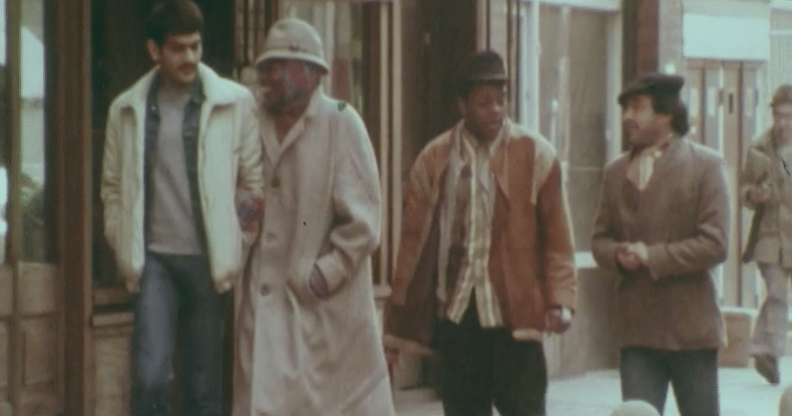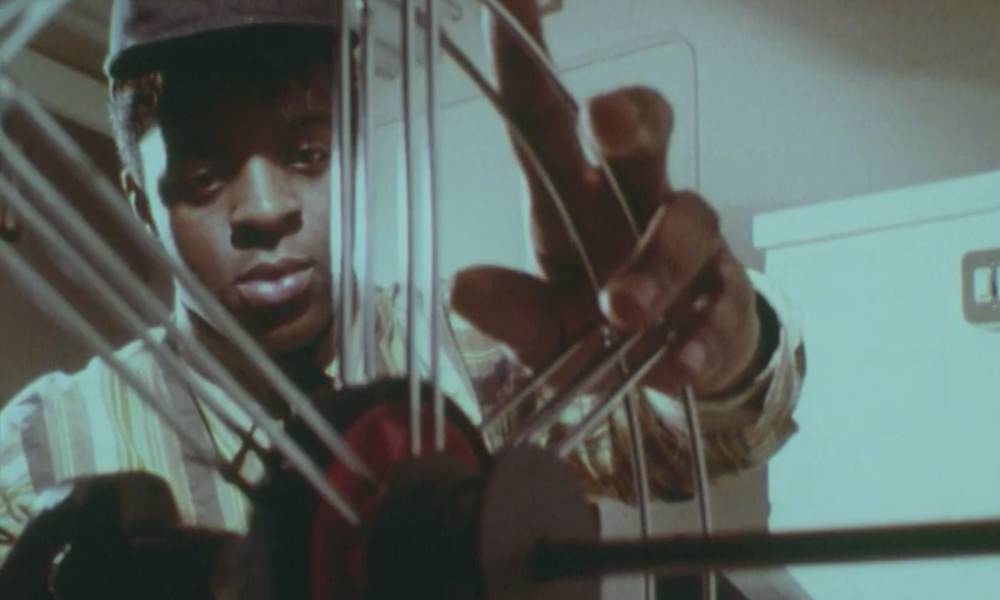Remembering a forgotten landmark in gay, Black, British history – and the lessons it can teach us

The opening scene of the film Gay Black Group. (BFI)
In the 1980s, the Gay Black Group became a landmark in British LGBT+ history.
Over the past two years especially, questions pertaining to Blackness, inclusion and diversity have dominated our news cycles and facilitated global dialogue. The resurgence of the Black Lives Matter movement last year has led to greater recognition of Black British history. Despite this, Black queer histories remain overlooked, out-of-print and even dismissed.
A Here and Now film from 1983 offers a rare insight into the history of Black LGBT+ organising in Britain.
Through interviewing Black and Asian members of the Gay Black Group (GBG), the film forces viewers to reflect on the marginalisation of LGBT+ people of colour and the importance of intersectional safe spaces. An invaluable primary source, it sees reporter Paula Ahluwalia document the challenges facing queer people of colour in hostile 1980s Britain – an exclusionary atmosphere that continues to pervade the LGBT+ community today.
The formation of the Gay Black Group in the 1980s was a landmark in gay black history, negotiating a path through the complexities of cultural and sexual identity.
?️? Film courtesy of @MACEarchive #BritainOnFilm #LGBTHM19 #LGBTHistoryMonth pic.twitter.com/m9KF64PLNZ
— BFI (@BFI) February 20, 2019
Sitting in London’s Gays the Word bookshop, a regular meeting place for the Gay Black Group, the members were filmed discussing the importance of their organisation. The group, formed in 1981, had mobilised under the notion of ‘political Blackness’, a popular solidaristic framework adopted by radical anti-racist organisations in the 1970s and 80s.
Political Blackness was deemed the most effective strategy in fighting against white racism as it encouraged all people of colour to unite through identifying as Black. Radical groups at this time often stated that their Black identity represented not their colour, but their anti-racist stance.
One member describes how white gay organisations lack “Black empathy” as “they profess to be non-sexist [and] non-racist, but they can’t really understand how we feel”. Before the Gay Black Group, they had joined white gay spaces and had been encouraged to come out in a “very white middle-class way”. This led to a family breakdown and them having to leave home.
Soon, the discussion turns to racial fetishism in the “gay scene”. Another interviewee describes the two types of people he has been confronted with in white gay spaces. One, he explains, “just want you for sex, and the other sort don’t want to know you at all”.
All of this makes for a “very lonely life” for Black gay people. Award-winning filmmaker Isaac Julien explains how Black queer people are objectified, exoticized and fetishised, recalling white gay men using terms such as “rough trade” to describe them. All of this, Julien concludes, leaves “no space for [one’s] own personality”.
The Gay Black Group, being the “only one in the country”, was met with hostility and accusations of it being an “extremist” group. Julien spoke of the “reactionary” response of his white gay friends which opened his eyes to the subtleties of racism within the LGBT+ community.
Another member, a freelance journalist and translator, explained how people of colour are “expected to normalise, [to] be heterosexual, and wash away parts of our identity”. In white queer spaces, she continues, they are “expected to bleach out [their] Black culture”. Simply by existing and allowing members to connect, the Gay Black Group allowed members to “reassert [their] culture” in a way they otherwise couldn’t.

Award-winning filmmaker Isaac Julien recalled white gay men using terms such as “rough trade” to describe Black queer people. (BFI Player)
The Gay Black Group had few female members. One woman explains that many “prefer to meet autonomously [and] prefer to work with women for women”. She goes on to explain how the role of Black women within the family, and within wider society, makes it “more difficult” for [them] to come out. Another barrier, she highlights, is the lack of “public Black female figures that are [openly] gay”. These discussions of intersectional pressures, visibility and on-screen representation are topics that remain just as relevant today as they were in 1983.
Cultural difference and how it impacts one’s ability to live openly is an overarching theme. One member, an Asian Kenyan, describes how his strict Hindu background prevented him from coming out. As the eldest, he became the head of his family once his father died and feared that coming out would make it difficult for his sister to find a partner due to homophobia within the Asian community. For him, “family is more important than sexuality”.
One of the most striking parts of the film is a segment with an interracial couple. Alan, a white man, talks of the jealousy he felt when his partner Ahmed joined the group. However, he saw the difference the Gay Black Group made to Ahmed’s life and it taught him “what it means to be Black and what it means to be Black and gay”. Before joining the group, he admits, their relationship had been “along white lines”, and he was “almost blind to the fact that Ahmed was Black”. Alan’s response reminds us of how identities intersect and result in people facing challenges on multiple fronts. Such discussions around intersectionality continue to be had to this day and remain just vital.
This film offers us a rare insight into the historic experiences of Black LGBT+ people in Britain. The Gay Black Group was radical in its ability to combat both homophobia and racism, offering a safe space that was sensitive to its members’ experiences. Without knowledge of when the film was made, one could easily mistake it for a report made today.
The topics discussed, such as fetishisation, intersectionality and representation, are topics that the LGBT+ community continue to grapple with. By engaging with our history and listening to people’s unique life experiences, we will be better equipped to face present-day challenges. Stories such as this are too often overlooked until October calls. It is our collective challenge to better engage with diverse histories all year round and use them to find creative solutions to today’s problems.
Watch the Gay Black Group via the BFI Player.

